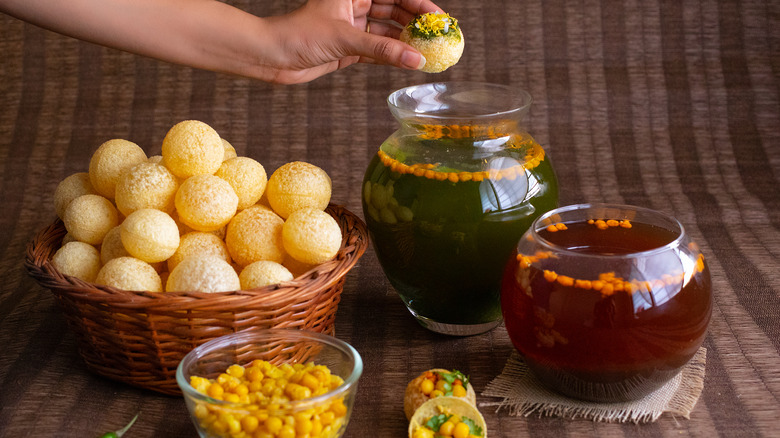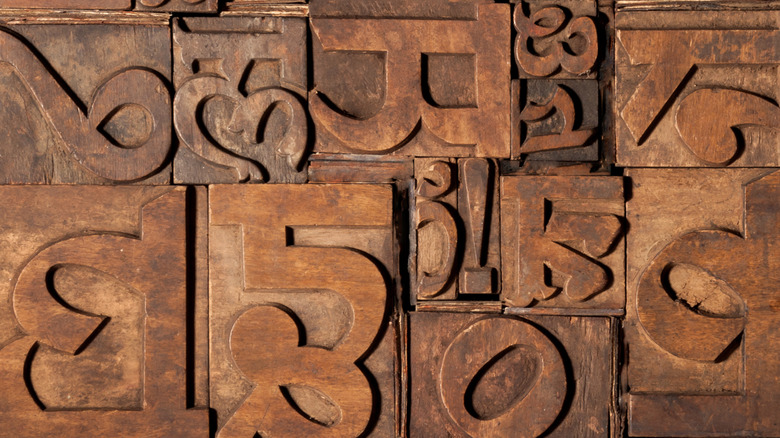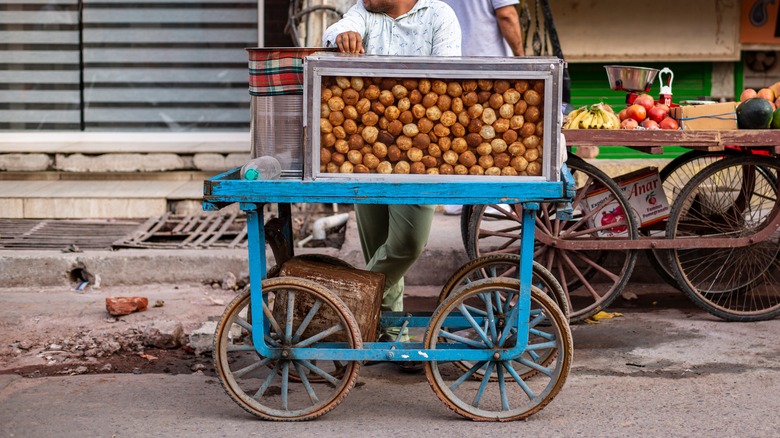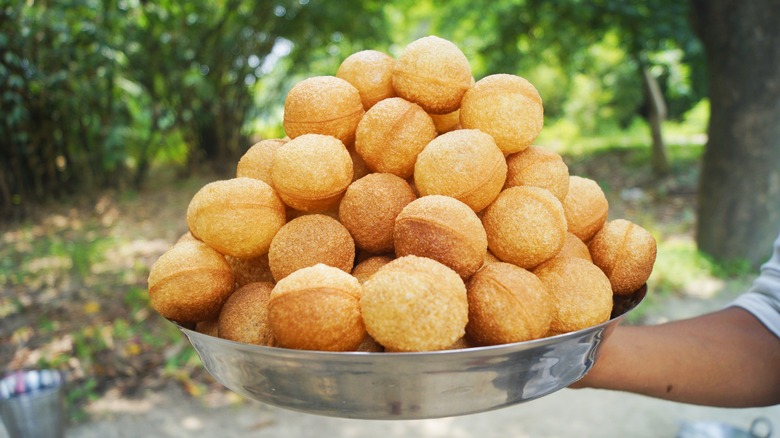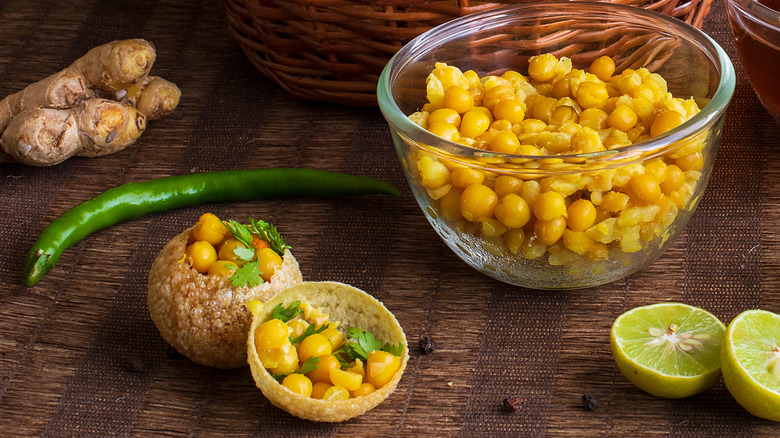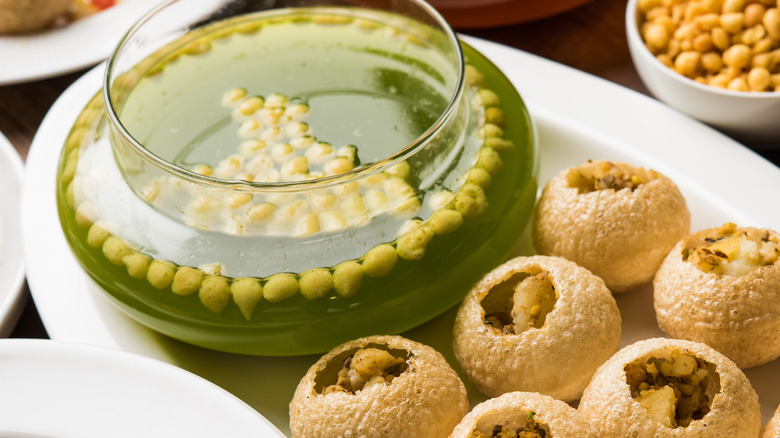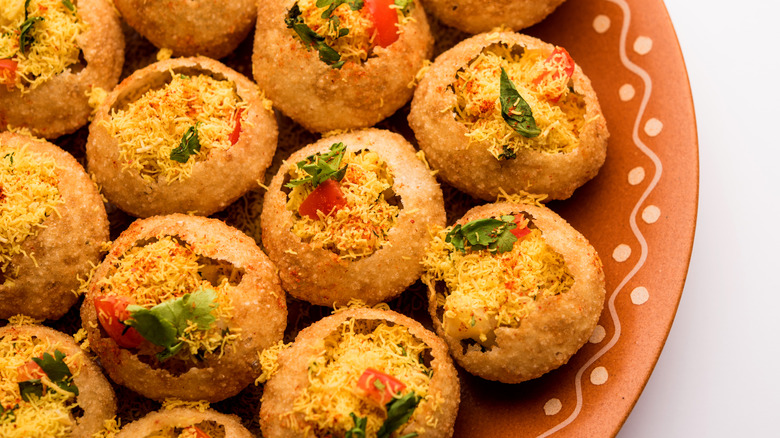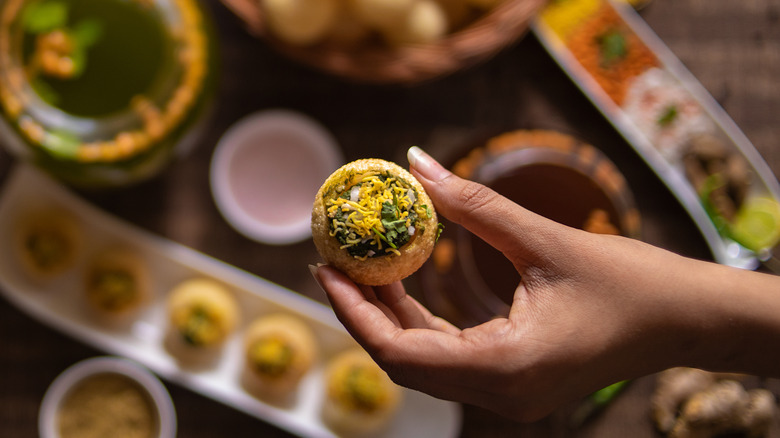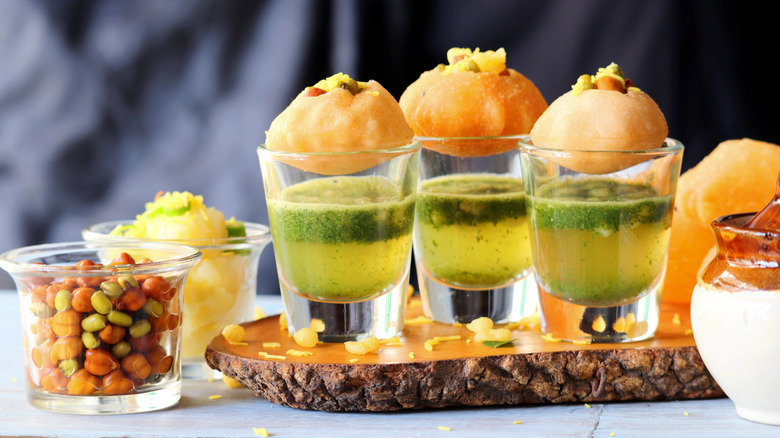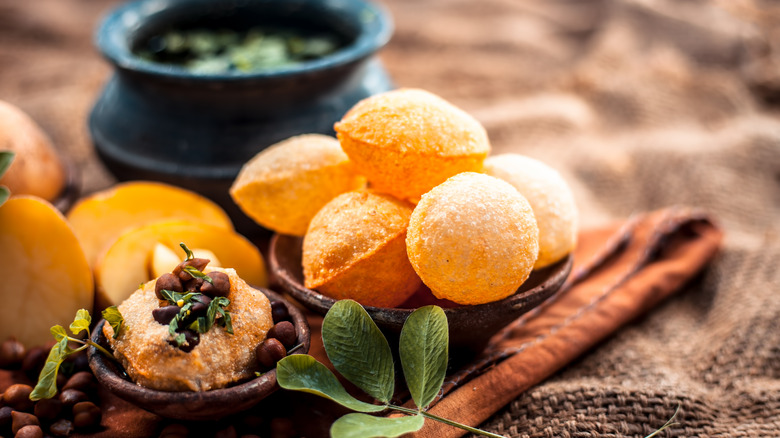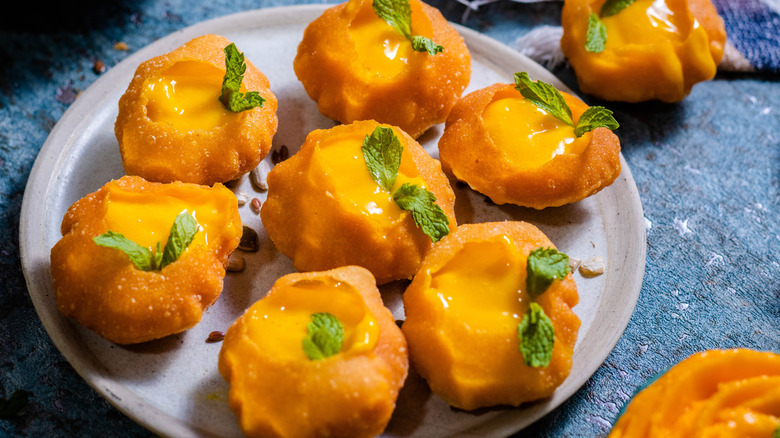The Ultimate Guide To Pani Puri, India's Beloved Chaat
Few cuisines are quite as famous for street food as India — from Mumbai's aloo pakora, Delhi's chole bhatura, and Gujarat's dabeli, each state has its delicacy that's just waiting to be explored. But one street food in particular reigns supreme over all others: chaat, a category of foods that a whole nation fell in love with. Even famed Bollywood producer Gauri Khan lists pani puri as one of her favorite street foods.
Somehow, the many flavors and textures marry together to create something so delectable and addictive that you just can't resist going for seconds. In fact, chaat is often said to be named for its literal meaning "to lick," (via The Hindu). Others suggest that chaat is named from the word "chatpata," meaning tangy or lip-smacking, pertaining to its distinctly piquant flavor.
Pani puri is one such chaat that has become so famous that it's arguably one of the most popular street food dishes to emerge from India. Imagine crispy, crunchy shells that encase a soft mixture of mashed potatoes and sprouted lentils that have been layered with tantalizing spice. Sounding good already? Picture dunking the whole thing in a tangy, sweet, sour, fresh, minty, and spicy chutney, then eating it all in one bite. Intrigued? Good. Let's explore pani puri.
The many different names of pani puri
Did you know that pani puri is just one name for this dish? While Babbel Magazine reports that there are 22 official languages of India, a jaw-dropping 19,500 regional languages or dialects are spoken as a mother tongue, (via The Indian Express). Because there are so many regional languages that have persevered — and even flourished — it's no surprise that one dish can have many different names, depending on where you eat it.
Pani puri, the name by which it is likely most ubiquitous, is mostly heard in Maharashtra. Per Collins Dictionary, the name translates to 'Water bread' — but we think that translation doesn't do it justice. North Indian states like New Delhi and Punjab, on the other hand, refer to the same dish as Gol Gappe, according to Times of India. Furthermore, the eastern states of Bihar, Jharkhand, and West Bengal know it as Puchka, while Nepalese people might recognize it under the name of Phulki. Other names include Pani ke Bataashe (Uttar Pradesh, Rajasthan), and Pakode (Gujarat, Madhya Pradesh). Gupchup, though, has to be the most interesting name on this list. Used mostly in Odisha, Hyderabad, Telangana, and Chhattisgarh, in English it translates to "silently," or "sneakily." Some people theorize that the name came about as while your mouth is filled with the spicy pani, you can't speak. Contrastingly, others suggest that it's because you silently sneak another (or two or three) into your mouth while nobody is watching.
The origin story
Every food has an origin story, and pani puri is no exception. Although there's no consensus on when pani puri truly originated, a few theories map out the history of this beloved snack.
According to The Better India, one such postulation is based on the Hindu religious text the Mahabharata. The source tells that in a test set forth by her mother-in-law, the newlywed Draupadi was instructed to use the house's scant resources of potato and wheat flour to make a dish that would gratify the hunger of all five of her husbands, the Pandavas. Draupadi rose to the occasion and invented pani puri. How likely is this story? Per Conde Nast Traveller, potatoes were brought to India by Dutch and Portuguese traders. The source continues by stating that the potato only picked up in popularity with the British East India Company in the 18th century. While the Mahabharata cannot be conclusively dated, most research suggests it was written between 900 and 2,000 BCE, (via The Economic Times). Although this means that it's extremely unlikely that pani puri as we know it today was invented by Draupadi, it certainly makes for an interesting legend.
The second prevailing theory is more believable: Republic World reports that pani puri had its beginning in the ancient kingdom of Magadha, now situated in the Eastern state of Bihar. It's this kingdom where phulki, a crispy bread, was first made. It's now understood to be the precursor to pani puri.
Where to eat pani puri
Spread all across India, there are thousands of tiny carts lining dusty streets. Each cart is stacked high with tempting pani puri, and hungry crowds need no persuasion to gather on masse to eat the famous chaat. From dawn to midnight, these pani puri walas sell countless pani puri served on traditional leaf plates to hungry passersby. Many restaurants have capitalized on the popularity of street food, too, offering a most relaxed dining experience with the same enticing taste. Tourists may enjoy the Sea Lounge at Mumbai's Taj Mahal Hotel, a majestic landmark dating back to 1903 and serving a unique afternoon tea featuring a variety of different chaats. The hotel also serves pani puri by itself if you only have room for a snack.
Indian restaurants across Europe have brought the street food of India to an international stage — perhaps none more so than the Indian restaurants of the U.K., where the Indian diaspora is 1.4 million strong, (via BBC). One such restaurant is Bhaji Pala, a Greater Manchester-based eatery that won the title of Best Vegan Restaurant, says the Manchester Evening News. It focuses on authentic Maharashtrian cuisine, including classics such as pani puri.
North America also has some extremely well-established Indian restaurants specializing in street food. Take Viks Chaat, featured in both the Michelin Guide and The New York Times, this long-standing Berkeley, California-based icon has been serving up meals for over 33 years.
What is puri in pani puri?
Puri are hollow and crispy shells that perfectly hold savory stuffing and tangy pani. They have a light texture and a hint of nuttiness which perfectly compliments the bolder, spicer elements of the dish.
The puri are made from a dough consisting of fine semolina rubbed together with oil, salt, baking powder, and a small amount of all-purpose flour. Made into a tight dough and cut into disks, they emerge from the deep fryer as puffy, crispy miracles. Making puri from scratch is arduous, so we recommend a trip to your local Indian grocery store where you're likely to find packets of uncooked puri disks to fry at home. If you're hosting a party, the best option is large boxes of ready-made puri, also found at large Indian grocery stores.
It's worth noting that across Indian cuisine, puri usually refers to a much larger bread that is typically eaten with chana masala or a semolina dessert called sooji halwa. Also deep fried, that variety of puri is much softer due to being made with atta, a stone-ground wheat flour used in India, which is different from Western wheat flour. Usually, a small amount of semolina is added, but the ratio of all-purpose flour to semolina is reversed compared to pani puri, which accounts for the textural difference. When you see the word puri used with any dish other than pani puri, it's safe to assume that it refers to the large, soft kind.
What fillings are used to stuff the puri?
Once the puri has been fried, they're ready to be stuffed with a variety of different savory options ranging from potatoes, beansprouts, chickpeas, and even curries. The most commonly found stuffing is made from boiled potatoes mixed with onions, fresh cilantro, and dried spice powders. We recommend using starchy potatoes like Russets or Yukon Gold, as they are commonly agreed to be the best potato variety for mashed potatoes. The combination of brittle puri with soft and fiery potatoes is the perfect introduction to pani puri for the newly initiated.
In Gujarat, you'll likely find pani puri stuffed with cooked moong lentils, while in the neighboring state of Maharashtra there are two common varieties — one with a steaming hot, thick, and creamy curry made from white peas (ragda), and the other with beansprouts made from moong lentils. Usually, potatoes are combined with an additional ingredient that is rich in plant-based protein or nutrients. Beansprouts, for example, are an excellent source of antioxidants and vitamin C, per WebMD.
Further north, you'll likely find that spiced chickpeas replace other fillings. You may be surprised to know there are two common varieties of chickpeas: Kabuli, otherwise known as garbanzo beans; and Desi chickpeas, otherwise known as Kala chana. The former is larger, with a mild flavor and creamy texture, while the latter is smaller, darker, and nuttier. Both can be used for pani puri, and are great sources of fiber and protein.
What is the pani in pani puri?
Pani translates from Hindi as water, (via the Collins Dictionary). In this case, pani means so much more than simply water — it's tangy, sweet, spicy, sour, fresh, and herby all at once. It's a flavor explosion that, if made correctly, is a party for the senses.
Similarly to the pani puri stuffing, many regional variations of the pani exist across India. Jaljeera, the most prevailing variety, combines fresh and zesty mint and cilantro leaves, tangy and tart tamarind paste, sharp and spicy green chilis, water, sweet caramel jaggery, peppery ginger, smoky cumin, the pungency of chaat masala, and intensity of black salt. It often has boondi (deep-fried batter pieces made from chickpea flour) added, which provides a welcome nuttiness and crunchy texture. This pani mixes a swathe of flavors into one, ensuring that every bite contains equal amounts of pleasure. According to Karishma Shah, a nutritionist speaking to The Indian Express, jaljeera has added benefits. She says the ingredients like mint and cumin help aid digestive issues.
Other vendors prefer to make two separate chutneys; teekha (sour and spicy), and meetha (sweet and tart). The first blends ingredients typical of an Indian green chutney: mint, cilantro, green chilis, and lemon juice. Lots of extra water is added, but the result is still packed with herby freshness and vibrancy. The second chutney is made by simmering tamarind, dates, jaggery, red chili powder, and cumin together, then blending them with plenty of water.
It's topped with crispy noodles and herbs
One of the defining characteristics of chaat is its toppings. Whisker-thin chickpea noodles, juicy pomegranate arils, and fresh herbs are all mainstays. Pani puri is no different. Although more simplistic versions may forgo the toppings, these extra few additions add another layer of complexity to the dish that pays off.
First, the herbs. Although some people claim that cilantro tastes like soap, it's one of the most widely used herbs throughout India. Sprinkling the tart and citrusy herb atop your stuffed puri not only adds an attractive appeal when serving but also contributes an intense flavor, echoing the more muted notes of cilantro throughout the pani we'll add later. Don't be afraid to chop up and add the stems of the cilantro, too, as they add flavor.
Sev, irresistibly crunchy chickpea noodles which feature on almost every chaat you can think of, are an optional but recommended addition. Sprinkle them on top of your puri before dunking them in the pani. The chickpea flour produces a pleasing earthy yet nutty flavor and an addictively crunchy texture that sings when paired with crisp puri, soft potato, and tangy, liquid pani. Nylon sev is best, but any variety works.
This is how you eat it
Eating pani puri from a street cart is incredibly simple. Hurriedly pass some rupees (Indian currency) to the owner in exchange for a singular pani puri on a woven leaf plate. Once you receive your pani puri, time is of the essence — lift it, and put the whole thing in your mouth all at once. This is the only way to eat pani puri; biting it is destined for disaster. Hand the plate back to the pani puri wala, and ask for another. He'll likely be too busy to even glance at you, simply working at lightning speed to present you with another flavor bomb. Take another, and another, until full.
Eating pani puri at home is a little more complicated. First, break a small hole in the top of the puri. Although your instinct may be to reach for a spoon, use your thumb to give the crisp puri a firm tap. Fill the hollow puri with ample spiced stuffing, then dip the whole thing in the pani to fill with the sweet, sour, and spicy chutney. Open wide, eat the whole thing at once, and feel the flavors and textures explode in your mouth. You have to be quick, or you risk the puri becoming soggy and leaking. As is typical of traditional Indian food, pani puri requires you to eat with your hands. It's not an elegant affair: It's messy, but also exhilarating.
Pani puri is amazing party food
Think of pani puri as an appetizer. As small, bite-sized snacks that can be eaten in one mouthful, pani puri are the perfect option for large catering events or parties. In recent years, people have even come up with unique ways to serve pani puri that looks sophisticated and unique: pani puri shots. Don't worry, these shots don't involve any alcohol (unless you want them to), but instead feature the stuffed puri delicately balanced on top of a shot glass filled with just enough sharp, fiery, and piquant pani to fill the puri. It makes a statement and elevates pani puri from a beloved street-side chaat to a modern dish worthy of the most spectacular parties.
Perhaps even more impressive, The Indian Express reports that pani puri fountains have been taking the internet by storm. As opposed to the classic melted chocolate, vibrant green pani is seen coursing through the fountain while people hold their puris in place to catch the flavorsome liquid.
If you'd rather opt for something a little more low-key, consider laying out small bowls of a variety of stuffing options, toppings, spice powders, and chutneys so your guests can build their perfect pani puri. It's a fun activity for children and adults alike, in addition to being a great conversation starter.
It's vegan and vegetarian
India is known as one of the most vegetarian-friendly countries in the world. According to Pew Research, 39% of Indians describe themselves as vegetarians, while 81% of adults restrict their meat consumption on certain days or abstain from eating certain animals altogether. This results in a country where vegetarianism is widely understood, and the majority of omnivores eat a high proportion of vegetarian food. Per ED Times, India has the highest population of vegetarians in the world, totaling over 400 million people.
Consequently, any traveler in India will find themselves overwhelmed by vegetarian-friendly choices, whether that be street food or fine dining. Vegans will have a slightly harder time: Although most Indians consider eggs to be non-vegetarian (via Scroll.in), products like yogurt, ghee, paneer, milk, and cream are still widely consumed. As a matter of fact, India is poised to become a world leader in the dairy sector, says The Hindustan Times.
Pani puri is suitable for both vegetarians and vegans — and we're sure omnivores won't be able to get enough, either. As standard practice, both the puri and stuffing should be made with oil as opposed to ghee, but if you're concerned, make sure to double-check. Unfortunately, however, pani puri isn't gluten-free. The semolina and wheat flour used in making the puri dough render this chaat unsuitable for those with gluten intolerance.
Variations of pani puri to try
To refresh, the standard pani puri recipe has a few variations: For stuffings, you have potatoes, white chickpeas (garbanzo beans), black chickpeas (Kala chana), white pea curry (ragda), moong lentils, and beansprouts. For the pani, you have jaljeera, sour and spicy, or sweet and tangy. For the toppings, you have sev, chivda (Bombay mix), pomegranate arils, and fresh herbs. Begin by experimenting with these variations to find your favorite combination for standard pani puri, then move on to some more surprising interpretations.
Meanwhile, street food vendors in India have taken pani puri to dramatic and theatrical new levels with the "fire pani puri" which has gone viral, according to NDTV Food. Likely inspired by the no less sensational street food fire paan, the pani puri is lit on fire and then thrust into your mouth, still ablaze. This one is truly for the adventurous foodies.
If you're not brave enough for fire pani puri, a clever riff on the traditional involves sweet, thick, and creamy mango-laced, cardamom-spiced, and yogurt piped inside the puri. It's a rendition of shrikhand puri, a traditional Indian dessert that features large puri and sweet-scented yogurt. Garnished with mint leaves, it makes for a pretty summer dessert. Chocolate pani puri is another variation perfect for those with a sweet tooth; it comprises chocolate-coated puri stuffed with chocolate cake and cream, before being drizzled with chocolate syrup.
